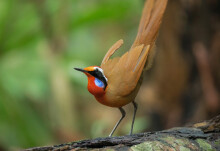

Dispersion tactics
How forest fragmentation affects birds depends on their wings
How easily birds can fly between suitable areas strongly determines whether a particular species can survive habitat fragmentation.



How forest fragmentation affects birds depends on their wings
How easily birds can fly between suitable areas strongly determines whether a particular species can survive habitat fragmentation.


Better governance in community-based conservation delivers few expected benefits
A study of community-run marine areas in Fiji shows that while mechanisms thought to lead to change were ‘activated’, they led to few tangible gains.


Changing temperatures increase pesticide risk to bees
Temperature influences how badly pesticides affect bees’ behaviour, suggesting uncertain impacts under climate change, according to a new study.
 4
4


Toxic pet flea and tick treatments are polluting UK freshwaters
Parasite treatments and preventatives we put on our pets are finding their way into UK waters in concentrations that are toxic to aquatic species.
 4
4


Being friendly but not too friendly helps sparrows breed successfully
A new study shows that sparrows with more opposite-sex friends contribute more to the gene pool, but ‘average’ friendliness wins out in the long term.


When ‘good genes’ go bad: how sexual conflict can cause population collapse
Males of a species evolving traits for sexual conflict can cause problems for females, and, ultimately, the whole population.


Imperial alum wins Arts Foundation 2023 Futures Award
An Imperial College London alumnus has won an Arts Foundation Futures Award Fellowships 2023 for her innovations that tackle climate change.


Woodcocks have the brightest white feathers ever measured
The mainly brown woodcock uses its bright white tail feathers to communicate in semi-darkness, reflecting 30% more light than any other known bird.
 2
2


Prioritise tackling toxic emissions from tyres, urge Imperial experts
Imperial experts are calling for more to be done to limit the potentially harmful impact of toxic tyre particles on health and the environment.
 4
4


Microbes that co-operate contribute more carbon emissions
Communities of microbes that work together release more carbon dioxide than competitive communities, contributing more to climate change.